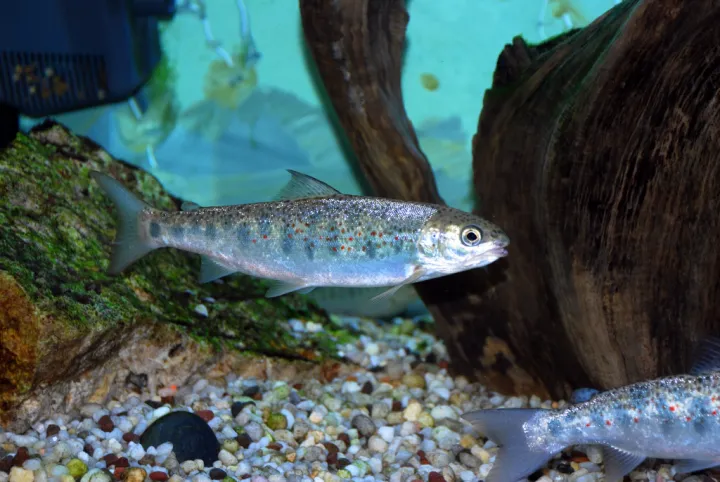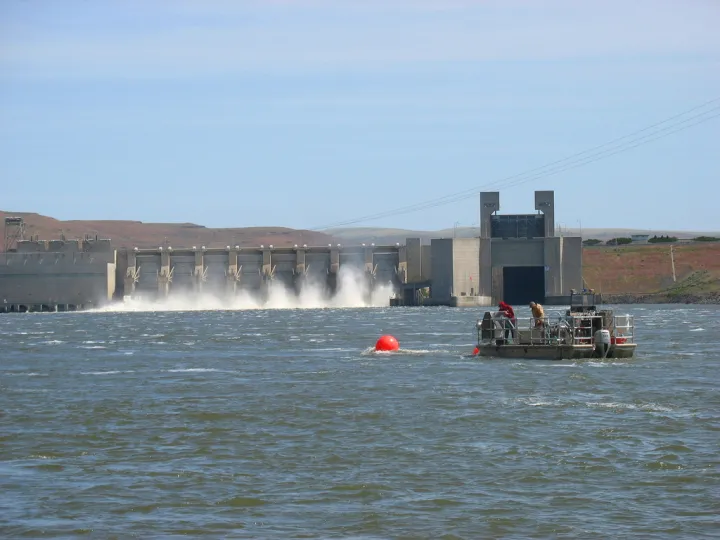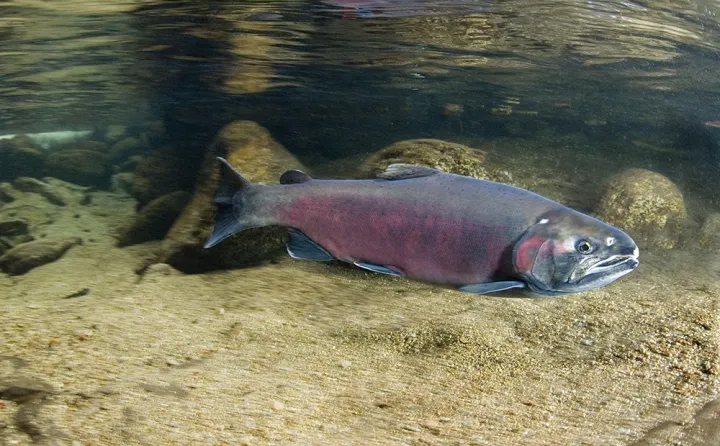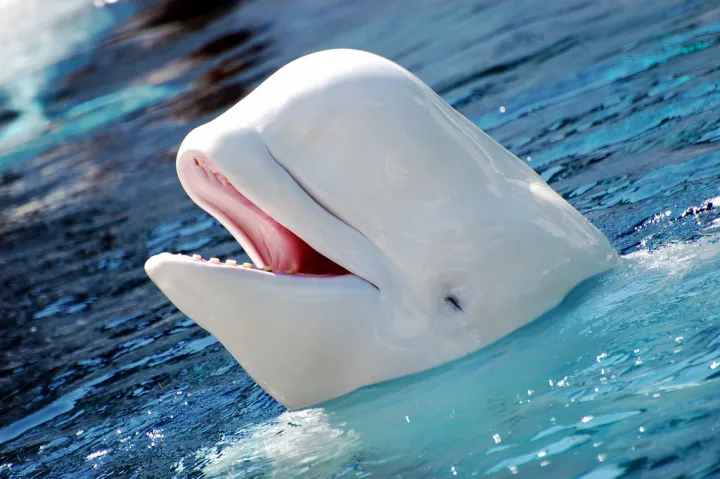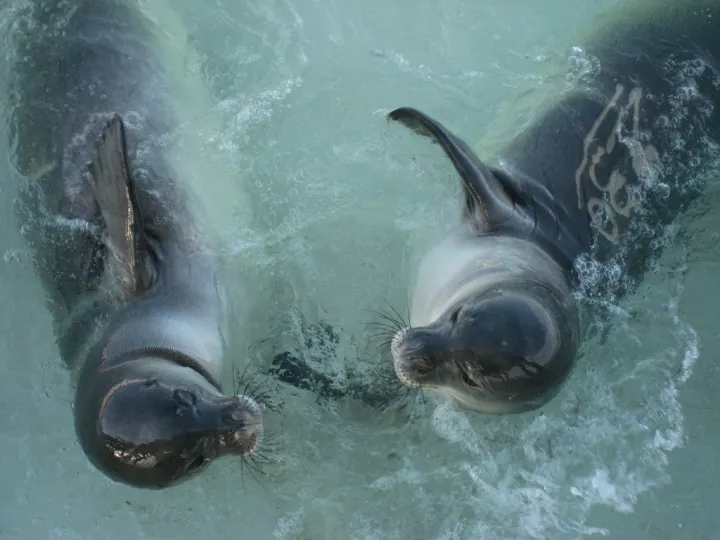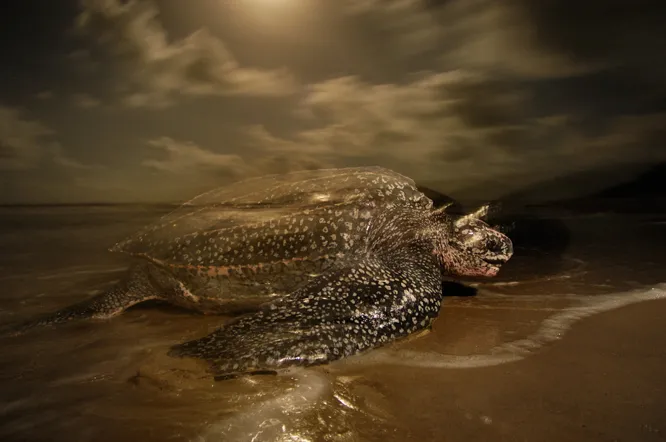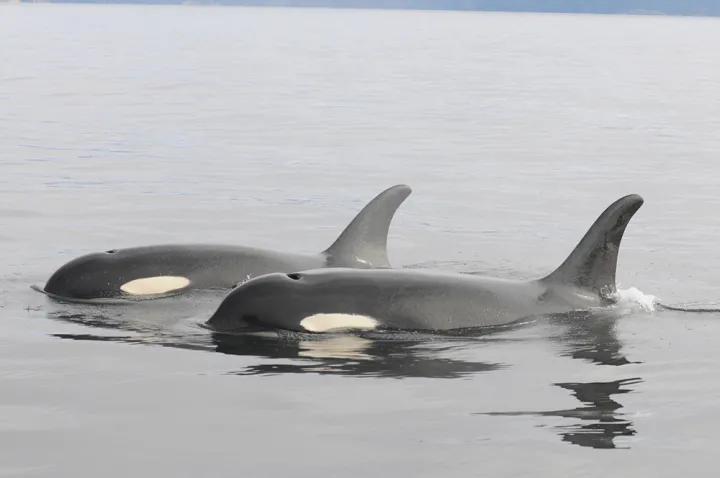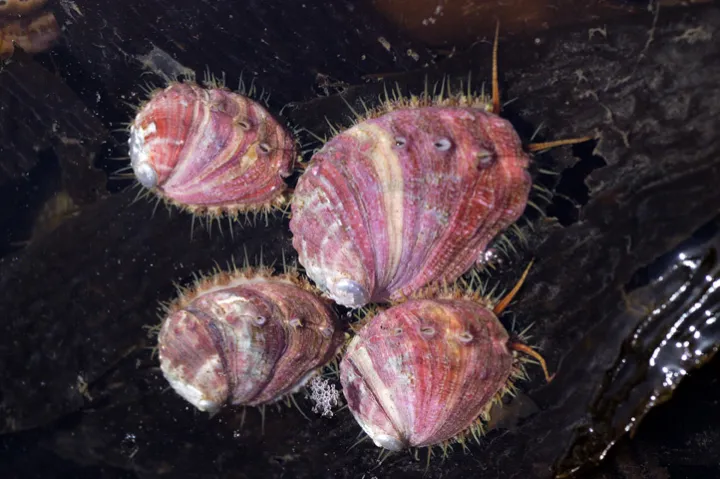Struggling to Survive, But with a Chance to Thrive
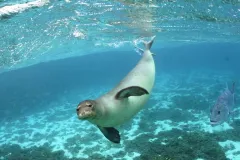
Progress for Eight Endangered Ocean Creatures
From snails to whales, approximately 2,270 species are listed as endangered or threatened globally under the U.S. Endangered Species Act (ESA). Of the species that are listed, approximately 150 of them live in the ocean in U.S. waters, and some are considered closer to extinction than others.
NOAA Fisheries works to support sustainable fisheries and the conservation and recovery of marine mammals and other endangered or threatened marine species in the United States. The agency has identified eight ocean creatures that are among the most at risk and have intensified efforts to help them recover. These eight species—NOAA Fisheries’ “Species in the Spotlight”—were identified because, although they face a variety of threats that have caused their populations to decrease drastically, they have the potential to survive and even thrive.
1. Atlantic Salmon in the Gulf of Maine
Atlantic salmon would be considered heavyweights in the boxing world; with some reaching up to 30 pounds they are among the largest of the eight salmon species. All of that weight provided food and jobs to many people in the Northeast region of North America in the 19th and early 20th centuries. In 1889 more than 17,000 individual salmon were caught by U.S. fishermen.
But this heavyweight has been hit with some pretty big punches and by 1947 the catch dropped to as low as 40 individuals because of overfishing and habitat degradation, among other threats. The decline of Atlantic salmon led to the closure of U.S. commercial fisheries in 1947 and their listing as endangered under the ESA in 2000. In 2004, the Atlantic salmon population in Maine was estimated to consist of only 60 to 113 individuals (PDF).
Happily, Atlantic salmon are no longer overfished (meaning that there are enough of the species in the wild to naturally replenish their population), but dams still block their way in many rivers, and salmon still face river habitat degradation. Atlantic salmon lay their eggs between rocks on the bottom of rivers, but these spaces are filling up with soil that washes in from development in surrounding areas.
This is where NOAA Fisheries enters the ring. The agency is focusing on removing dams and restoring salmon habitat, starting with restoration in the heart of Atlantic salmon country on the Penobscot River. They also support hatcheries raising large numbers of Atlantic salmon in safe and enclosed environments for release into the wild. States around the Gulf of Maine are reducing the impacts of recreational fishing and other sources of disturbance. Individuals are planting native plants around rivers to keep soil from washing away.
Removal of dams in the Penobscot River has restored access to over 1,000 km (621 miles) of rivers and streams. While the population has not recovered to historical numbers, a large number of hatchery salmon return to spawn each year, keeping the population from extinction and if efforts continue the species are expected to recover.
2. Sacramento River Winter-run Chinook Salmon
Chinook salmon are an icon of California’s natural heritage and an important part of the economy—they are the most commercially valuable of the salmon species. Salmon are also inextricably linked to water. In a state where water is extremely scarce, salmon need a helping hand. Water from the Sacramento River in the northern part of the state is diverted to drier parts of Southern California for drinking water and agriculture through a series of pumps and gates. The competing demand for water has created a difficult challenge and jeopardizes the existence of Sacramento River winter-run Chinook.
These pumps and gates don’t just divert water, they also sweep juvenile salmon south rather than out to sea. The longer journey means that fewer salmon survive due to predation in delta ecosystems, low water levels, and water that is too warm. This is one of the many reasons why Chinook salmon populations in central California are critically endangered. The population of Sacramento River winter-run Chinook salmon went from over 4 million juveniles in 2009 swimming out to sea to just over 200,000 in 2015. In just 2 years, between 2013 and 2015, the value of the Chinook fishery harvest in California dropped from almost $23 million to $8 million.
Scientists with NOAA Fisheries and state agencies are working to address the competing needs for the available water. Chinook salmon are now implanted with tags that track their location, allowing scientists to know when the fish are near the pumps. When salmon are nearby the pumps can be turned off to allow them to pass, and when the salmon are not nearby and there are large pulses of water after a rain, the gates can be opened.
3.Central California Coast Coho Salmon
Although they spend most of their life in the ocean, when it's time to reproduce coho salmon return to rivers along the West Coast for a Romeo and Juliet-like story of fleeting romance and a final act of death. Swimming up-river against the currents, they expend all of their energy to start another generation and subsequently die from exhaustion. After death, the nutrients stored in their bodies provide a new source of energy to the surrounding plants and animals.
Unfortunately, this source of life is dying—the Central California Coast coho salmon population is listed as critically endangered under the ESA. An estimate of between 200,000 and 500,000 individual coho salmon lived in Central California in the 1940s, but by the late 1980s that number dropped dramatically to an estimated 6,000 (PDF). Degradation of crucial streams and increased stream temperatures are a few of the natural and human causes for this dramatic decrease.
NOAA Fisheries and its state partners have worked hard to revive this population. In 2009, a wildfire came within inches of destroying the facility used to ensure that juvenile salmon make it to reproductive age. The local fire captain, who happened to be involved with the salmon restoration, stayed up all night to protect the precious juvenile fish. In a state riddled with drought issues, crops and fish often fight for precious water. Also in 2009, coho salmon faced untenably low water levels resulting from farmers attempting to protect their crops from frost by spraying them to coat them with ice. Hatchery programs, dam removal, and even genetic matchmaking play a role in restoration of the coho population.
These efforts are working: in 2014, 24,800 coho salmon returned to their place of birth to spawn, making it the largest number of returning adults seen in more than ten years.
4.Cook Inlet Beluga whales
The words “baby beluga in the deep blue sea” may trigger a familiar childhood song in your head, and Raffi was scientifically correct when he wrote “Sing your little song, sing for all your friends, we like to hear you.” These white whales have an entire repertoire of songs. While they are one of the more social species of whale and use sound to communicate, beluga whales use their songs for much more. Their chirps and whistles are also used to find openings in the ice where they can breathe.
The hunting of beluga whales by Alaska Natives for subsistence, in addition to other human and natural threats, caused the Cook Inlet population of belugas to decline by an estimated 71 percent since 1979. Alaska Natives now limit their hunting of beluga whales to only two animals a year (and often none at all). But the population isn’t recovering as expected and has been listed by NOAA Fisheries as critically endangered. Noise is listed by the agency as a “threat of high concern”—human activity in the region, such as ship engines and drilling for oil, creates underwater noise, which makes it difficult for belugas to communicate.
Alaska Natives, the oil and gas industry, fishing groups, environmental organizations, federal and state agencies and other interested groups are working together to return belugas to the stage. NOAA Fisheries has developed a guide to limit the amount of noise pollution under water and industry has responded by developing technology that reduces the amount of sound their equipment releases.
5. Hawaiian Monk Seals
Most seals live in cold water but the Hawaiian monk seal, as its name suggests, has found a tropical paradise to call home. The beaches of Hawaii are the only place in the world where these seals exist. As if on a tropical vacation, they spend a lot of time napping on the beach. These beaches are also used by mother monk seals to raise their young pups away from predators, such as tiger sharks.
However, their tropical vacation is not all-inclusive. While scientists still don't have all of the data they need, several signs indicate lack of food as the main cause for population declines since the late 19th century. Some of these signs include smaller than expected pups and mothers producing a smaller number of pups, suggesting the mothers do not have the energy and resources needed to reproduce and raise healthy offspring. Another possible threat is the outbreak of disease. Kris Helgen, a zoologist at the Smithsonian’s National Museum of Natural History who studies the monk seals’ evolutionary history, says disease has the potential to wipe out their population. These threats and others have contributed to a significant decline in their population and led to their being critically endangered.
In order to keep this tropical seal from extinction, their next meal is on us. NOAA Fisheries and other organizations established rehabilitation centers for juvenile seals found starving on the beach. They are fed and watched over until they return to a healthy state and then are returned back to the wild. These and other efforts have cut the population decline in half. Dr. Charles Littnan, lead scientist with the Hawaiian Monk Seal Research Program, reports that 30 percent of the 1,200 monk seals alive today are a result of these efforts.
6. Pacific Leatherback Sea Turtle
Leatherbacks are the only sea turtles whose shells are not hard but rubbery and more skin-like. They are also the largest of the sea turtle species, growing up to 7 feet long and weighing 2,000 pounds. However, Pacific leatherback sea turtles aren’t able to bounce back like their rubbery shells may suggest. Because of their continuing decline, the Pacific leatherback is listed as critically endangered.
Numbers of western Pacific leatherbacks have dropped by more than 80 percent and eastern Pacific leatherbacks by more than 97 percent since the 1980s. Turtle nests are threatened by invasive species, sea level rise and climate change. Adult turtles often get tangled in fishing gear or are unintentionally hooked by a fishing line. The massive turtles also mistake plastic bags for floating jellyfish and consume the plastic thinking it’s dinner.
Fortunately, creative technological changes can win this race to recovery. Fishermen in the United States are no longer allowed to use the types of fishing gear that these turtles get stuck on. The circle hook—named for its circular shape—is less likely to be swallowed by a turtle than the traditional J-shaped hooks, and is generally easier to remove. This has reduced the number of sea turtles caught unintentionally by 83 percent since the rule was established. In Hawaii, “barbless” circle hooks are replacing the traditional barbed circle hooks and make the de-hooking process even more successful.
7. Southern Resident Killer Whale
Orcas (also counterintuitively referred to as both “killer whales” and “sea pandas” because of their ruthless hunting and similar coloring to the cuddly bamboo-eaters) serve as a symbol for the conservation of all species. The Southern Resident killer whale is no exception. While they aren’t the ones you may have seen skillfully knocking seals off of floating ice to grab a bite to eat, they are picky hunters that feed strictly on fish.
Southern Resident killer whales are critically endangered due to their historical removal from the wild for aquaria and high levels of contamination and noise from boat traffic, among other reasons. There are only 80 individuals left of a population that consisted of around 200 in the 1800s. While they are no longer removed from the wild, the population has not fully recovered.
Despite the many threats they face, we now understand much more about these animals and what it takes to protect them from extinction. NOAA Fisheries determined which contaminants have the greatest effect on these whales, and works to minimize them by monitoring their input into coastal waters via dumping and preventing spills. Whales were found to hunt less and travel more if boats were nearby, so new regulations were established for vessels approaching the whales, which prohibit them from being within 200 yards. The recovery process is slow—the agency estimates it will take between 14 and 28 years and require additional research and international cooperation with Canada. But if efforts such as these continue the Southern Resident killer whale population is expected to recover.
8. White Abalone
The white abalone is a marine snail that lives in coastal ecosystems down to 200 feet (61 meters) below the ocean’s surface. They are found along the West Coast of the United States and Mexico in kelp forests and rocky bottoms. Considered a delicacy, they once supported a lucrative fishery.
That fishery depleted the white abalone population down to one percent of its original size and placed the invertebrate on the critically endangered list. Millions of these marine snails existed along the West Coast but now there are estimates of only 1,500 individuals in total. No longer harvested, they are still struggling to recover. Their densities are so low that males and females who need to be in close proximity to reproduce are spread too far apart. To help stave off extinction, NOAA Fisheries has partnered with the University of California to play matchmaker. They are breeding these snails in captivity with the intent of re-introducing individuals back into the wild, increasing their overall population density and allowing them to reproduce naturally in the future. Thousands of snails have been produced in captivity by these efforts. Further research on the best methods for reintroduction is being conducted before any are returned to the wild.


